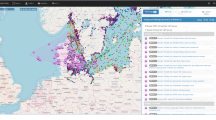Abstract
The important ship navigation systems radar and ECDIS (Electronic Chart Display and Information System) offer a large amount of both route monitoring and collision avoidance functionalities to navigators. We conducted an online survey to investigate if navigators really need all functionalities assuming that route monitoring functionalities are mainly needed on ECDIS and collision avoidance functionalities are mainly needed on radar systems. N = 80 experienced nautical officers completed the online survey and evaluated the functionalities according to their importance and their frequency of use. As expected, the need for functionalities was task dependent, indicating that functionalities on ECDIS and radar systems should be prioritized accordingly. Thus, the results of this survey can be used to guide display design of modern ECDIS and radar systems by considering user needs.
Access this chapter
Tax calculation will be finalised at checkout
Purchases are for personal use only
Similar content being viewed by others
References
Endsley, M.R., Jones, D.G.: Designing for Situation Awareness: An Approach to User-Centered Design, 2nd edn. CRC Press, Boca Raton (2004)
Thompson, D.V., Norton, M.I.: The social utility of feature creep. J. Mark. Res. 48, 555–565 (2011)
Vu, V.D., Lützhöft, M., Emad, G.R.: Frequency of use – the first step toward human-centred interfaces for marine navigation systems. J. Navig. 72, 1089–1107 (2019)
IMO: Adoption of the revised performance standards for radar equipment. International Maritime Organization, London (MSC.192(79)) (2004)
IMO: Adoption of the revised performance standards for integrated navigation systems (INS). International Maritime Organization, London (MSC.252(83)) (2007)
IMO: Adoption of the revised performance standards for electronic chart display and information systems (ECDIS). International Maritime Organization, London (MSC.232(82)) (2006)
Hareide, O.S., Ostnes, R.: Maritime usability study by analysing eye tracking data. J. Navig. 70, 927–943 (2017)
Dobbins, T., Hill, J., Brand, T., Thompson, T., McCartan, S.: Standardised information architecture to support the Dynamic Navigation (DYNAV) standard operating procedure. In: The Royal Institution of Naval Architects 2016. Human Factors Conference, p. 7 (2016)
ISO: Ergonomics of human-system interaction – Part 210: Human centred design for interactive systems. International Organization for Standardization, Geneva (ISO 9241–210) (2019)
Grech, M., Lemon, N.: Human centred design for enhanced navigation systems: shifting the focus on user needs. In: PACIFIC 2015 - 9th International Maritime Exposition & Conference, Sydney (2015)
van de Merwe, F., Kähler, N., Securius, P.: Crew-centred design of ships – the CyClaDes project. Transp. Res. Procedia 14, 1611–1620 (2016)
Sandhåland, H., Oltedal, H., Eid, J.: Situation awareness in bridge operations – a study of collisions between attendant vessels and offshore facilities in the North Sea. Saf. Sci. 79, 277–285 (2015)
IMO: Report of the Maritime Safety Committee on its eighty-fifth session. International Maritime Organization, London (MSC 85/26) (2008)
Leiner, D.J.: SoSci Survey (Version 3.1.06) (2019)
Cohen, J.: Statistical Power Analysis for the Behavioral Sciences, 2nd edn. Lawrence Erlbaum Associates, Hillsdale (1988)
Field, A.P., Miles, J., Field, Z.: Discovering Statistics Using R. SAGE Publications Ltd, London (2012)
Acknowledgments
The study was part of a project funded by the German Federal Ministry of Transport, and Digital Infrastructure. We would like to thank Bergmann Marine and the Fraunhofer CML for their support. Especially, we would like to thank all the mariners that were kind enough to participate in the survey.
Author information
Authors and Affiliations
Corresponding author
Editor information
Editors and Affiliations
Rights and permissions
Copyright information
© 2021 The Author(s), under exclusive license to Springer Nature Switzerland AG
About this paper
Cite this paper
Hochgeschurz, S., Motz, F., Kretzer, S., Thiele, L. (2021). Task Oriented Use of Functionalities on Ship Navigation Systems. In: Stanton, N. (eds) Advances in Human Aspects of Transportation. AHFE 2021. Lecture Notes in Networks and Systems, vol 270. Springer, Cham. https://doi.org/10.1007/978-3-030-80012-3_54
Download citation
DOI: https://doi.org/10.1007/978-3-030-80012-3_54
Published:
Publisher Name: Springer, Cham
Print ISBN: 978-3-030-80011-6
Online ISBN: 978-3-030-80012-3
eBook Packages: EngineeringEngineering (R0)




